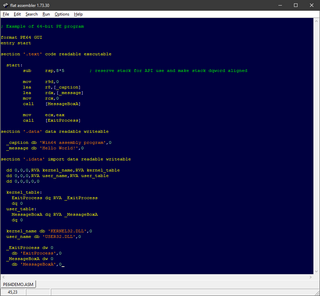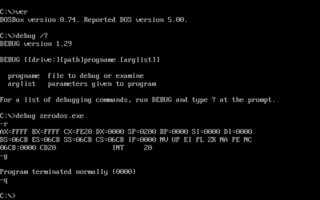Related Research Articles

In computer programming, assembly language, often referred to simply as assembly and commonly abbreviated as ASM or asm, is any low-level programming language with a very strong correspondence between the instructions in the language and the architecture's machine code instructions. Assembly language usually has one statement per machine instruction (1:1), but constants, comments, assembler directives, symbolic labels of, e.g., memory locations, registers, and macros are generally also supported.

In computer programming, a macro is a rule or pattern that specifies how a certain input should be mapped to a replacement output. Applying a macro to an input is known as macro expansion. The input and output may be a sequence of lexical tokens or characters, or a syntax tree. Character macros are supported in software applications to make it easy to invoke common command sequences. Token and tree macros are supported in some programming languages to enable code reuse or to extend the language, sometimes for domain-specific languages.
A disassembler is a computer program that translates machine language into assembly language—the inverse operation to that of an assembler. Disassembly, the output of a disassembler, is often formatted for human-readability rather than suitability for input to an assembler, making it principally a reverse-engineering tool. Common uses of disassemblers include analyzing high-level programing language compilers output and their optimizations, recovering source code of a program whose original source was lost, malware analysis, modifying software, and software cracking.

FASM is an assembler for x86 processors. It supports Intel-style assembly language on the IA-32 and x86-64 computer architectures. It claims high speed, size optimizations, operating system (OS) portability, and macro abilities. It is a low-level assembler and intentionally uses very few command-line options. It is free and open-source software.
In software development, Make is a build automation tool that builds executable programs and libraries from source code by reading files called makefiles which specify how to derive the target program. Though integrated development environments and language-specific compiler features can also be used to manage a build process, Make remains widely used, especially in Unix and Unix-like operating systems.
A low-level programming language is a programming language that provides little or no abstraction from a computer's instruction set architecture—commands or functions in the language map that are structurally similar to processor's instructions. Generally, this refers to either machine code or assembly language. Because of the low abstraction between the language and machine language, low-level languages are sometimes described as being "close to the hardware". Programs written in low-level languages tend to be relatively non-portable, due to being optimized for a certain type of system architecture.
x86 assembly language is the name for the family of assembly languages which provide some level of backward compatibility with CPUs back to the Intel 8008 microprocessor, which was launched in April 1972. It is used to produce object code for the x86 class of processors.
INT is an assembly language instruction for x86 processors that generates a software interrupt. It takes the interrupt number formatted as a byte value.
The C preprocessor is the macro preprocessor for several computer programming languages, such as C, Objective-C, C++, and a variety of Fortran languages. The preprocessor provides inclusion of header files, macro expansions, conditional compilation, and line control.
CodeView is a standalone debugger created by David Norris at Microsoft in 1985 as part of its development toolset. It originally shipped with Microsoft C 4.0 and later. It also shipped with Visual Basic for MS-DOS, Microsoft BASIC PDS, and a number of other Microsoft language products. It was one of the first debuggers for MS-DOS to be full-screen oriented, rather than line-oriented.
High Level Assembly (HLA) is a language developed by Randall Hyde that allows the use of higher-level language constructs to aid both beginners and advanced assembly developers. It fully supports advanced data types and object-oriented programming. It uses a syntax loosely based on several high-level programming languages (HLLs), such as Pascal, Ada, Modula-2, and C++, to allow the creation of readable assembly language programs, and to allow HLL programmers to learn HLA as fast as possible.
Turbo Assembler is an assembler for software development published by Borland in 1989. It runs on and produces code for 16- or 32-bit x86 MS-DOS and compatible on Microsoft Windows. It can be used with Borland's other language products: Turbo Pascal, Turbo Basic, Turbo C, and Turbo C++. The Turbo Assembler package is bundled with Turbo Linker and is interoperable with Turbo Debugger.
In computer programming, an inline assembler is a feature of some compilers that allows low-level code written in assembly language to be embedded within a program, among code that otherwise has been compiled from a higher-level language such as C or Ada.
The Microsoft Macro Assembler (MASM) is an x86 assembler that uses the Intel syntax for MS-DOS and Microsoft Windows. Beginning with MASM 8.0, there are two versions of the assembler: One for 16-bit & 32-bit assembly sources, and another (ML64) for 64-bit sources only.
The IBM Basic assembly language and successors is a series of assembly languages and assemblers made for the IBM System/360 mainframe system and its successors through the IBM Z.

The line-oriented debugger DEBUG.EXE is an external command in operating systems such as DOS, OS/2 and Windows.

C# Open Source Managed Operating System (Cosmos) is a toolkit for building GUI and command-line based operating systems, written mostly in the programming language C# and small amounts of a high level assembly language named X#. Cosmos is a backronym, in that the acronym was chosen before the meaning. It is open-source software released under a BSD license.
Open Watcom Assembler or WASM is an x86 assembler produced by Watcom, based on the Watcom Assembler found in Watcom C/C++ compiler and Watcom FORTRAN 77. Further development is being done on the 32- and 64-bit JWASM project, which more closely matches the syntax of Microsoft's assembler.

MAC/65 is a 6502 assembler written by Stephen D. Lawrow for the Atari 8-bit family of home computers. MAC/65 was first released on disk by Optimized Systems Software in 1982, with the program requiring 16 KB RAM. A bank switched "SuperCartridge" from OSS followed in January 1984 for US$99, occupying only 8 KB.
In computing, Java bytecode is the bytecode-structured instruction set of the Java virtual machine (JVM), a virtual machine that enables a computer to run programs written in the Java programming language and several other programming languages, see List of JVM languages.
References
- 1 2 Isaacson, Eric (2008). "A86/A386 assembler and D86/D386 debugger". Archived from the original on 2 July 2008. Retrieved 2008-07-02.
- 1 2 Randall Hyde. "Which Assembler is the Best?". Archived from the original on 15 May 2008. Retrieved 2008-05-18.
- ↑ Isaacson, Eric (2006). "A86/A386 and D86/D386 features".
- ↑ Isaacson, Eric (2006). "A386 and Win32 Programming".
- ↑ Hague, James (July 20, 2008). "Kilobyte Constants, a Simple and Beautiful Idea that Hasn't Caught On". Programming in the 21st Century.
- ↑ El-Khalil, Rakan; Keromyti, Angelos D. (2004). "Hydan: Hiding Information in Program Binaries" (PDF). In Lopez, Javier; Qing, Sihan; Okamoto, Eiji (eds.). Information and communications security: 6th International Conference, ICICS 2004, Malaga, Spain, October 27–29, 2004 : Proceedings. Lecture Notes in Computer Science. Vol. 3269. Springer. p. 190. ISBN 3-540-23563-9.